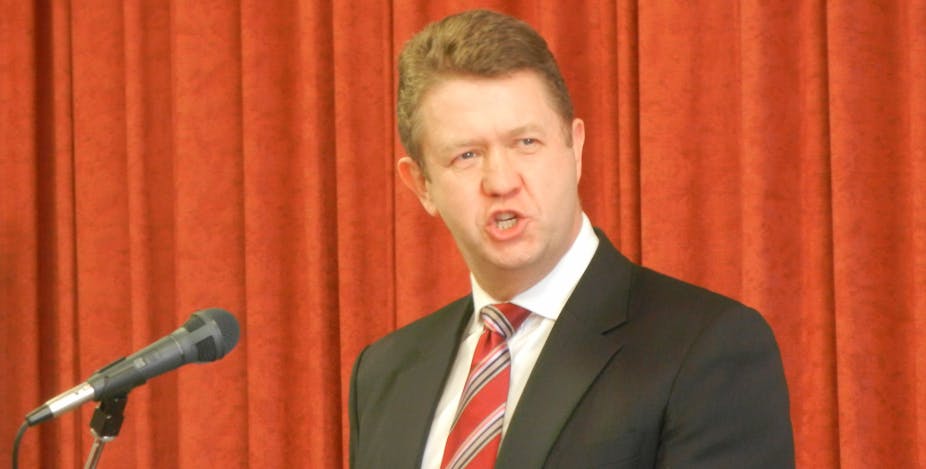While Australia’s Labor Party is digesting a significant electoral defeat, the New Zealand Labour Party, in opposition since 2008, has gone through another leadership change and is positioning itself to compete for office at the next general election, to be held by November 2014.
Labour not only has a new leader in David Cunliffe, but for the first time used a “primary-style” internal party process for electing him. And some have compared Cunliffe to Kevin Rudd. With Anthony Albanese and Bill Shorten engaging in the first contest for the leadership of the ALP involving a direct vote by party members, the Cunliffe result is worth examining in detail.
But first, some background. Helen Clark’s Labour-led government was defeated in 2008, just after the worst of the global financial crisis had struck. The incoming minority conservative National-led government was headed by prime minister John Key. National were returned to office in the 2011 election with 47.3% of the party vote, the largest ever under the proportional representation system in place in New Zealand since 1996.
Labour, by contrast, gained a mere 27.5% of the party vote, and a contest for the party leadership began soon afterwards in early 2012. This was won by David Shearer, whose main rival was Cunliffe. Shearer, however, never really cut it as leader of the opposition. Relatively new to parliamentary politics, Shearer spent most of his career in humanitarian work in the developing world. He lacked experience and insider savvy, and rarely displayed the cut-through required of a politician on television and in the debating chamber.
Shearer narrowly avoided the sack by resigning, and this set in train a new process for Labour to elect its leader – a ballot weighted 40% for caucus, 40% for paid-up party members and 20% for affiliated trade unions. Hustings events were quickly set up across the country and the process was covered extensively by the news media.
As there were three candidates, a preferential vote was applied.
Cunliffe won on the first round with a total of 51%, but only a third of his caucus colleagues voted for him. Nearly half of them preferred instead his closest rival, former deputy leader Grant Robertson. It was the wider party membership and affiliates whose votes won the race for Cunliffe.
Naturally this has raised questions about how unified the Labour caucus will be under Cunliffe’s leadership, but the desire to win office in 2014 may well take care of that, at least on the surface. In the meantime, though, the prime minister can taunt the leader of the opposition about an apparent lack of support from his caucus colleagues.
The party election results also reflect what many have said for some time about Cunliffe – that he is very intelligent and articulate, with a media presence that Shearer lacked, but with a divisive style. He appeals to the party rank and file but is prone to being a bit grandiose and seemingly narcissistic – or at least he fails to hide those less desirable self-regarding traits that are probably quite common among political leaders. Many of those who have to work with him appear to be less than keen. Hence the comparisons (justified or not) with Kevin Rudd.

The important comparison for Cunliffe, though, will be with John Key, the present prime minister. Key’s intelligence and business nous are combined with an unassuming and down-to-earth manner that connects well with Kiwi voters, while simultaneously making sense to “the markets.” He has seen off three Labour opponents so far, and his government is in good enough shape at present to help him see off this next contender.
Key’s repeated message is that Labour is heading to “the far left.” As Labour will probably need a coalition with (at least) the Green party to form a government, then a vote for them next election is also implicitly a vote in favour of the Greens. And there is no doubt that Labour’s recent “primary” election has shown that their strategy is to pitch for the left, especially for the one third of those eligible who did not vote in 2011.
Their aim is thus to shift the position of the median voter to the left by encouraging the poor and disfranchised who didn’t vote last time to vote Labour next time. Hence, Cunliffe has made promises about raising low wages and taxing the well-off in order to win that support.
This is a socially worthy but politically high-risk strategy for Labour, especially if it means losing ground from the all-important centre. As an Ivy-league educated, business-friendly middle-class white guy, there is a risk that Cunliffe simply won’t inspire the unemployed or low-income workers, especially Maori or Pacific-Islanders, to come out and vote for him.

